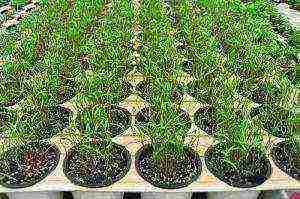Content [show]
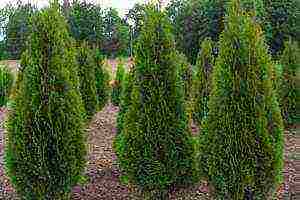
Columnar thujas are one of the varieties of western thujas used in landscape design of both public recreation areas and personal plots.
Like all thuja, it has good adaptation to various growing conditions.
Characteristic
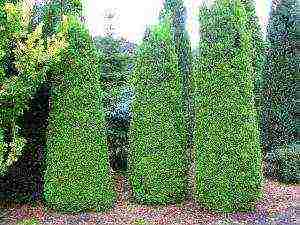 Among the main characteristics of thuja it should be noted:
Among the main characteristics of thuja it should be noted:
- The growth of an adult tree can reach 30 meters. Moreover, it has been growing for about 100 years. In a year, it grows up to 20 cm in height. The diameter reaches 1.5 meters.
- Differs in high resistance to low temperatures, so in the winter season you can not cover. But at the same time, in very hot weather, it requires additional watering.
- Differs in high resistance to insect pests and diseases.
- Amenable to haircut. At the same time, a haircut from above stimulates growth in width, and from the sides - in height.
Planting and leaving
 As a rule, thujas are able to adapt to any growing conditions.
As a rule, thujas are able to adapt to any growing conditions.
But in order for the trees to grow and develop effectively, they need additional care, especially when it comes to young seedlings.:
- watering once a week;
- in the evening at night, the seedlings are sheltered from the coolness;
- regular feeding, mixtures for coniferous species for fertilization can be bought in specialized stores;
- loosening the soil should be done from time to time, in parallel to mulch - cover the ground around the tree with peat, dry grass or sawdust.
Such a layer will not only retain moisture for a longer period of time, but also gradually feed the tree through the root system. When cold weather approaches, the layer will also protect the roots close to the surface from freezing.
Note: columnar thuja of all
varieties of western thuja
are characterized by increased tolerance to low temperatures.
Caring for mature plants is also pretty simple:
- in prolonged dry weather, trees are watered twice a week and sprayed. This results in additional moistening of the needles twice a day and at the same time the dust and dirt is washed off from the crown. This should be done in the early morning and evening with twilight;
- fertilization is carried out in the spring;
- loosening of the earth should also be carried out regularly.
For columnar thuja, animal urine is destructive. Therefore, it is necessary to provide for a fence from animals.
Reproduction rules at home
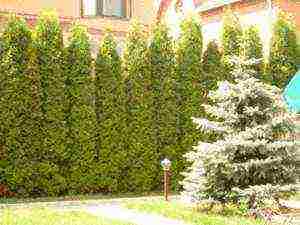 As a rule, amateur gardeners propagate thuja by cuttings.
As a rule, amateur gardeners propagate thuja by cuttings.
Slightly stiff cuttings are picked up, separating them from the branch by tearing, but not cutting. The cultivation of future seedlings has its own characteristics, as well as their planting.
- For germination, cuttings are placed in a warm room.
- The cuttings must be lignified.
- First of all, after collecting the cuttings, future seedlings are placed in water, then after 2 hours they are placed in the ground.
- The soil should be composed of peat, turf and sand. River sand is better.
- Landing is done in the autumn season, long before the onset of cold weather.
Important recommendations
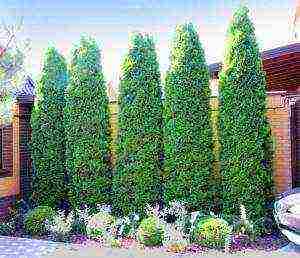
- To create a dense thuja hedge, seedlings are planted in an even straight row at a distance of 0.5 meters from each other.
- The first pruning of seedlings is carried out immediately after planting. In this case, the height is aligned with the lowest seedling in the entire row. If the planting was at the beginning of autumn, then the plant is cut off the next spring.
- At first, thuja can be trimmed with an ordinary pruner. But the more mature the tree becomes and the thicker its crown, the more powerful the tool is needed. For example, electric scissors.
- When purchasing a thuja dug out of the ground, pay attention to the clod of earth holding on to the root system. It should not crumble, be large. When planting thuja, the hole in width should be wider than the earthen lump. The depth should be 80 cm.
- With age, the thuja dries up a little and crumbles from below. To hide this annoying drawback, you can plant undersized densely growing shrubs (for example, quince) in front.
- A way to protect thuja from dog urine: You can surround the plants with a net or thorny bushes (for example, barberry).
- For the winter, it is recommended to fix the top of the tree with a rope, as it can deform and ruin the entire appearance of the plant.
What a large columnar thuja looks like and how tall it can be, see the following video:
Rate the article
To make your beloved garden pleasing to the eye, you only need to observe a few canons - to arrange a lawn, pave a path, plant flowers, and settle gnomes. And the heart of any northerner gravitates towards the tree. It's bad that it takes years to wait for the moment when the forest beauty grows in breadth and upward. The corresponding charm is used mainly as a single decor, so many gardeners have long liked the thuja planting and care which is in many ways similar to the agricultural technology of traditional conifers.
Thuja species and varieties
Information about thuja has come to us since antiquity, when people used pine needles for various rituals. In particular, we are talking about incense, which in Latin is pronounced as "Thuja". However, the heroine of the theme is also well known to the peoples of America and Far Asia. Otherwise, what other trees could the cherry blossoms pass the baton to?
Although the definition of "tree" fits thuja only conditionally: today the "life" plant has more than 100 varieties, some of which are represented by the so-called. cultural varieties. Their cultivation is relevant in landscape design, where it is not necessary to talk about century-old giants. But the corresponding segment only welcomes various coniferous dwarfs and cypresses higher. Well, thanks to breeders, thuja managed to transform itself in different colors, sizes and even crowns. Regarding the last thuja, it happens:
- Columnar;
- Spherical;
- Pyramidal;
- Conical.
On a note
In spring and summer, thuja in the country and in the garden requires pruning, thanks to which the plant can also be given a certain "head of hair". But in a biological way, the shape of the thuja crown is influenced by its variety. He also determines the height. For example, columnar and cone-shaped varieties, as adults, can reach 8 or more meters in height, while globular shrubs are mainly 0.7-1.5-meter dwarfs ”
Compared to the prickly tree, the needles of the thuja, although needle-like, are soft. The latter feature is facilitated by the scaly arrangement of the needles, which is especially noticeable when the age of the shrub is many years. But the opposite position of small branches positively affects the decorative appearance of the coniferous culture.
The most grown western thuja - varieties
In Russia and the CIS countries, thuja western is widespread, which can easily withstand extreme frosts.The number of its varieties exceeds a dozen, but the most popular can be counted on the fingers of one hand:
- Brabant;
- Golden Globe;
- Danica;
- Columna;
- Emerald.
The given five will not leave without answers to the most pressing questions: "how stunted is the garden thuja?", "What is its height and diameter?" does everything fit? " etc. From here it makes a lot of sense to get to know each representative better.
Thuja Brabant

Thuja western Brabant
First of all, the great popularity of the western Brabant variety is due to its size and ability not to change its green color in winter. The culture can reach a height of 7-12 meters, in diameter - 2-4 meters. These indicators by default tie Brabant to the columnar thuja category, which is very beneficial to use for creating a continuous coniferous hedge.
Brabant requires frequent haircuts. It is very frost-resistant, which negates its pre-winter preparation: only young cuttings need shelter with spruce branches. With high-quality agricultural technology, the tree becomes 30-40 cm taller every year.
Thuya Golden Globe
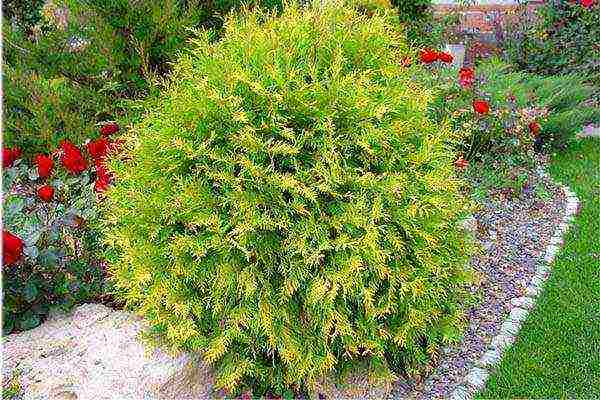
Thuja western Golden Glob
Not every thuja in landscape design is able to combine the shape of a ball and a golden color. Therefore, Golden Globe must appeal to gardeners looking for extravagant solutions. In particular, we are talking about rock gardens and color compositions, which are very suitable for small gardens in Japanese or English style. Surrounded by variegated inflorescences and tall spruces, "golden" thuja will certainly delight.
Golden Globe develops up to 1 and 1.2 meters in height and diameter, respectively. The annual growth is 10 cm. The main thing is good lighting. Frost is experiencing 4+.
Tuya Danica
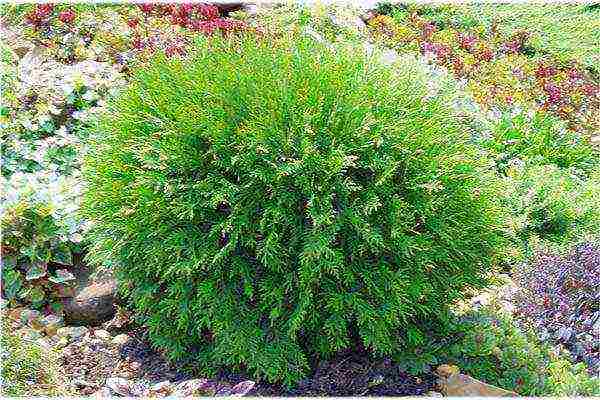
Thuja western Danica
Another representative of the spherical thuja family, but this time the representative is dwarf and green: the height of an adult Danica is 0.7-1 meter, the diameter is no more than one meter. The small size and green color make the variety relevant for planting in small groups, mainly 3 bushes each.
Like Golden Globe, Danica is welcome in rock gardens. You can also decorate large containers and patios with miniature needles, place them along the paths, coupled with flowers, creating wonderful mikborders.
Compared to Golden Glob Danica does not require landing in a well-lit area. With a good organization of the shelter, it winters favorably. It grows slowly - up to 10 cm per year, but it retains the shape of a "soft pillow" without the need for frequent pruning.
Thuja Columna
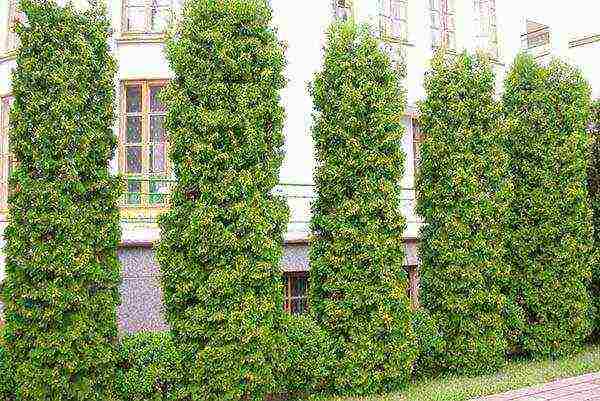
Thuja western Columna
If the plot is large, made in the Art Nouveau or Art Nouveau style, then you should pay attention to the slender and dark green Columna. At 10 years old, it can reach a height of 3 meters and a diameter of 0.7 meters. Despite its narrow crown, the needles grow quite luxuriantly, which makes Columna suitable for single growth. But mostly it is chosen for the organization of high hedges. In addition to modern trends, narrow thuja is relevant in the creation of southern landscapes, in which Tuscan cypresses and poplars always take place.
Despite its characteristic south-facing lush image, Columna is hardy. Therefore, it remains green even in winter. The coniferous giant only needs good lighting. Columna is also responsive to fertilizing, regular watering and a haircut.
Thuja Smaragd
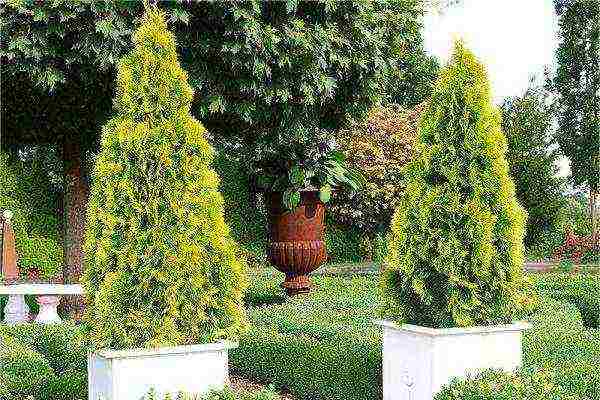
Thuja western Smaragd
The Smaragd variety closes the chain of leaders. The growth of this thuja and the narrowness of its top make it conical. At the age of ten, Smaragd reaches 2-2.5 meters in height and a meter in diameter. The western thuja in the garden does not stop at this, and continues to develop up to 4-5 meters. The appropriate height, coupled with a sharp top, make Smaragd an ideal tree for group plantings, if the garden is designed in a southern style, or for isolated cases when the undersized flower beds lack a giant.
The versatility of Smaragda is also manifested in agricultural technology: the variety is resistant to an unstable climate, never loses its magical emerald color, and can grow in partial shade.
Summing up regarding the common varieties of Tui, it will not be superfluous to review the characteristics of each representative, but already in a table format:
Table "Brief characteristics of Western thuja varieties"
| Brabant | Columnar | 12-4.0 m | Gigantism, frost resistance, fast growth, permanent bright green color | Group plantings to create a solid hedge |
| Golden Globe | Spherical | 1.0-1.2 m | Golden salad color, frost resistance, demanding light | Rock gardens, colored compositions |
| Danica | Spherical | 0.8-1.0 m | Dwarfism, frost resistance, unpretentious care | Rock gardens, containers |
| Columna | Conical | 5.0-1.5 m | Regular crown, frost resistance, permanent dark green color, survivability in partial shade | Single growth, group planting in modern and southern landscapes |
| Emerald | Conical | 5.0-2.0 m | Stately crown, frost resistance, permanent emerald color, survivability in partial shade | Single growth, group planting in modern and southern landscapes |
On a note
Some designers have learned to give a lush cone-shaped and columnar thuja a spiral shape by trimming the "tops". This look is best suited to modern styles. But the spherical thuja is convenient to set the image of animals, stars, etc.
Planting and caring for thuja
Reproduction of decorative needles is carried out by seed and cuttings. You can do it easier - buy an adult thuja or a more or less strengthened seedling in a large pot. But then you have to spend more money. In addition, a natural question arises: "How to choose thuja?" The tutorial here is simple:
- Firstly, the highest quality products are sold in themed establishments - in nurseries, garden shops;
- Secondly, a good seedling gives off a pleasant aroma of needles, has a fresh and bright color that corresponds to the variety;
- Thirdly, the absence of dry needles, brittle branches and various spots indicates that thuja agricultural technology was carried out with a bang;
- Fourthly, when buying, you need to ask when the irrigation was carried out (root watering and spraying), is the land fertilized? This will allow you to maintain the correct care regimen for the thuja after its relocation.
Video "Tips for buying conifers - choose the thuja"
Thuja planting time
Indeed, much still depends on the time when the landing is made. The fact is that the heroine of the theme must take root in a new place. To do this, she puts down fresh roots. In order for the corresponding process to proceed fruitfully, decorative needles must be planted in spring and summer, when the soil has time to warm up.
A hole is dug under each adult seedling. It should be twice the size of the earthen coma where the thuja grows. This is necessary so that the well can be additionally filled with a nutrient substrate from three equal parts:
- Sod land - loosens the soil, equalizes the ratio of useful elements;
- Peat - saturates the earth with nitrogen and contributes to the preservation of moisture;
- River sand - stabilizes the drainage system.
If the groundwater is high, the pit must be made 15 cm deeper in order to be able to fill its bottom with rubble, pebbles or broken brick. This bed will carry excess water downward.
On a note
Adult thuja can also be purchased in autumn. But then it will have to be kept indoors or on the balcony throughout the winter. Moreover, the plant will have to be covered with a film so that it enters the hibernation period.
Planting by cuttings
The cuttings repeat the biological characteristics of the thuja from which they were plucked. Therefore, the cuttings method of propagation is widespread. Let's consider it in stages:
- First, thuja propagation by cuttings requires 15-20 cm seedlings 2-3 years old. Accordingly, the planting material must be taken from a long-term healthy thuja;
- Secondly, the cuttings should not be cut, but broken off, pulling out the bark, so that a pod is formed at the end of the planting branch, which is also called "heel" or "foot". The latter on the reverse side has a large area for the growth of roots, which cannot be said about a straight cut;
- Thirdly, for planting, it is necessary to use a nutritious soil of three components (it was mentioned above);
- Fourth, before planting, the root is recommended to be dipped in a stimulant like Kornevin;
- Fifth, planting holes are best done at a 45-degree inclination. This will increase the grip of the "heel" by the ground and, accordingly, speed up the rooting of seedlings, so as not to once again ask the question: "How to plant thuja?" The depth of the holes themselves should be 5-7 cm;
Sixth, after planting, the seedlings must be poured with 10-15 liters of lukewarm water. The latter will not only give an impetus to the growth of the root system, but also warm the soil.
On the
In order for the seedling to release more energy to the roots, 20-40% of the green needles growing along the edges of the branches can be cut off. In the future, she will still grow
Seed planting
With the seed method of reproduction of thuja, the varietal characteristics of the mother tree are not transferred. Therefore, it is used primarily by breeders wishing to develop a new variety. To do this, they collect small brown thuja fruits in late autumn, which are formed at its tips, and then stratify them. That is, the bumps must first dry completely and open up. So they are ready for wintering under a large layer of snow. Moreover, the fruits should be placed in bags, which will increase the level of survival in harsh conditions. In early spring, the seeds should be planted in centimeter holes. Surviving cones will sprout, and it remains to take care of them, as required by the thuja agricultural technology of seedlings.
On a note! When planting-transplanting thuja, a lot of attention will have to be paid to the quality of lighting. From February to April, being unprepared for an increase in daylight hours, thuja turns yellow and dries. Therefore, it is recommended to cover it with spunbond or spruce branches for the winter. The exception is light-loving varieties (Golden Globe, etc.). Thuja also turns yellow after winter due to a lack of minerals in the soil. To fill this gap, in the spring, the top layer of the earth must be mixed with fresh peat. This must be done carefully, because thuja has a superficial root system. Root feeding with fertilizer for war plants will not be superfluous
Thuja diseases and pests
In general, yellowness and dryness can serve as signs of both improper care and the invasion of diseases and pests. It is very difficult to see thuja pests with the naked eye, because among them there are:
- Spider mite;
- Coniferous aphid;
- Bark beetle;
- Leaf roll;
- Click Beetle.
Against the corresponding insects, the drug Fufanon has proven itself well. But thuja of the disease is best treated with Acrobat or Fundazol. They do an excellent job with the following ailments:
- Rust;
- False shield;
- Brown spotting;
- Phytophthora.
On a note
To be effective, fungicides for fungal diseases and pesticides for pests must be alternated every month. Moreover, spraying is necessarily preceded by pruning of a thuja: it is necessary to remove all dried branches with a pruning shears
As a result, the main care for thujas after planting includes:
- Watering - every week (water consumption for each bush is 10-50 liters) or 2 times a week if it is hot;
- Spraying from a hose - every week (thuja loves to take a "refreshing shower") or 2-3 times a week in hot weather;
- Pruning - every 2-3 months;
- Top dressing - 2 times per season;
- Loosening - in the summer after each watering (you should try not to damage the surface roots);
- Preventive treatment - every month.
On a note
Preparation of thuja for winter is carried out if the culture is young or belongs to undersized spherical varieties. As already mentioned, spruce branches or spunbond are used for shelter. How to cut the needles will be told by its variety, as well as the style that the gardener strives for. The flight of fantasy is endless here
In pursuit of high-quality landscape design, it becomes clear how beautiful thuja planting and leaving seem difficult only at first glance. If you approach the matter responsibly, thuja will surely thank you with wonderful coniferous charm!
Thuja is an evergreen coniferous plant belonging to the cypress family.
It is a tree or shrub with scaly leaves and cracked bark. The crown is dense, dense, the branches grow in the same plane. Young specimens have needle-shaped needles. The color range of plants varies from pale green to red. There are many bicolor variegated varieties.
The title photo is Thuja occidentalis “Golden Smaragd”.
According to the shape of the crown, the thuja is divided into:
- columnar;
- pyramidal;
- wide conical;
- spherical.
Thuja columnar is a compact plant, 1.5-2.5 m in height and 0.5 - 0.8 m in width.
Columnar varieties
"Brabant" (Thuja occidentalis "Brabant")
By the age of 10, it grows more than 3.5 m, 1 - 1.5 m wide. Grows rapidly, broadly columnar. Growth per year 30 cm. Whimsical to moisture and soil composition. Great for forming hedges. Density of disembarkation in a row is 0.5 - 0.7 m.
"Yellow Ribbon" (Thuja occidentalis "Yellow Ribbon")
By the age of 10 it grows up to 2 - 3 m, 0.8 - 1.2 m wide. Narrow conical loose shape and bright yellow needles. Loves nutritious soil. Looks great in contrasting color compositions, ideal for tapestries.
"Columna" (Thuja occidentalis "Columna")
By the age of 10 it grows up to 3 m, 0.5 - 0.8 m wide. It grows quickly, the crown is narrow-columnar. The leaves are dark green. Whimsical to growing conditions. Looks beautiful in the form of hedges, and as a vertical dominant in landscape compositions. Disembarkation in a row 0.6 - 0.7 m wide.
"Smaragd" (Thuja occidentalis "Smaragd")
At 10 years old it grows up to 2.5 m, with a width of 0.5 - 0.8 m. The crown is narrow-columnar. One of the most popular varieties. The needles are dark green, do not turn brown in winter. Requires soil and watering. Used for single landings. When disembarking in a row, observe a distance of 0.5 - 0.6 m.
"Aurea Pyramidalis" (Thuja occidentalis "Aurea Piramidalis")
At 10 years old, the height is up to 2.5 m. The crown is narrow, with the years it increases in volume due to the formation of 1 - 3 trunks. Shoots are flexible, slightly curled. Ideal for planting in groups and as tapeworms. Demanding on soil and watering.
"Holmstrup" (Thuja occidentalis "Holmstrup")
At 10 years old it grows up to 2 m, 0.5 - 0.8 m wide. It grows slowly, the shape is narrow-columnar. Shoots grow fan-shaped, dense needles of intense dark green color. Loves nutritious and moist soil. Suitable for single plantings and compositions, cemeteries. For hedges, the distance in the row is 0.6 - 0.7 m.
Thuja folded "Aurescens" (Thuja plicata "Aurescens")
Height up to 8m - 12m, 3 - 4m width. An evergreen columnar tree with dense branches. The needles are dark green with white stripes. Demanding on the composition of the soil. Suitable for large-scale gardens and parks, group and single plantings.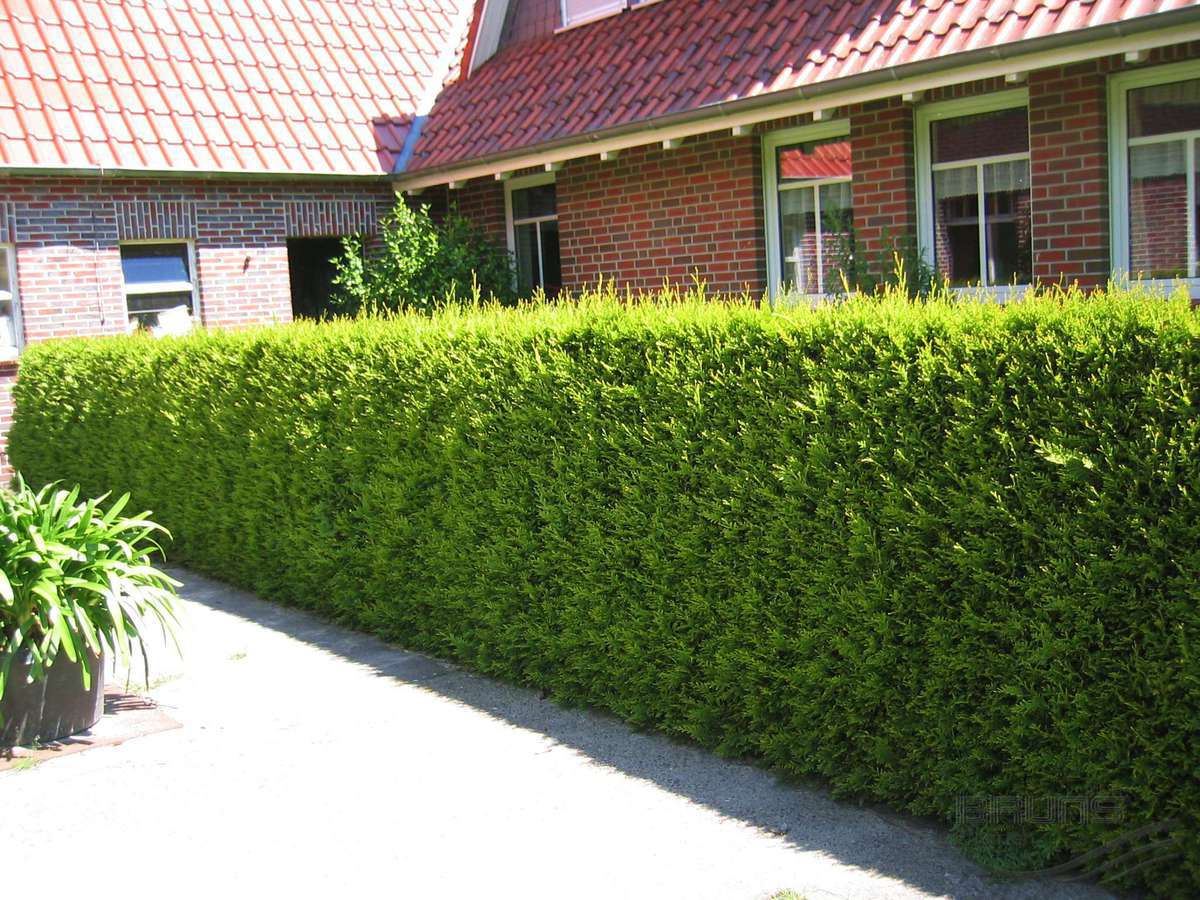
Thuja folded "Excelsa" (Thuja plicata "Excelsa")
Height 9 - 12m, 3 - 4m wide. The tree grows in the form of a column with arched, upwardly directed branches. The needles are dark green, dense, shiny. Loves nutritious soils. Suitable for spacious gardens and parks, solitary and group plantings and for vertical accent in powerful landscape compositions.
Landing
It is advisable to plant thuja older than 3 years with a preserved lump, the size of which should be approximately half the diameter of the crown. The size of the planting pit is usually 60 to 100 cm for plants up to 3 m.
Important: when planting in the ground, the root collar should be at ground level.
Therefore, initially it is necessary to plant so that the root collar is about 5 - 10 cm above ground level, because after watering, the soil is compacted and settles.
For planting, a soil mixture is taken from sod or deciduous land, peat and sand in a ratio of 2: 1: 1.
It is imperative to use complex mineral fertilizing (nitroammofoska, etc.) - about 150-200 g per planting hole. Having previously mixed them with the soil.
After planting, abundant watering is required - at least 2-3 buckets of water per hole for an adult seedling.
Advice: to improve the development of the root system and growth, it is advisable to use drugs such as "Kornevin".
Care
In the first month after planting in a permanent place, the thuja is watered 1 - 2 times a week, about 1 - 3 buckets per plant. If the planting was carried out in the spring, then sprinkling of the crown is favorable for survival.
Attention: to prevent moisture loss, the trunk circle should be mulched.
For this purpose, the bark of conifers, wet peat, leaf humus, garden compost, and needles are used. In addition, the mulch, decomposing, serves as food for the roots, and also protects against freezing in winter.
Thuja has a shallow root system, therefore, you need to monitor soil moisture. With insufficient watering or drying out, its crown may partially crumble and thin out. During the growth period, the plant is watered twice a week with 1.5 - 2 buckets of water per seedling.
In the process of leaving, it is necessary to loosen the soil to a depth of about 10 cm.
For a safe wintering, it is advisable to wrap the thuja with agrofibre. This will protect it from freezing, sunburn, and from ruffling the crown with snow.
Top dressing
If the plant is planted in well-prepared soil, then 1 - 2 additional fertilizing per year will be enough. In the spring, nitrogen-containing mineral fertilizers (ammonium and calcium nitrate, urea) are applied. At the end of summer - calcium and fertilizing containing phosphorus (superphosphate, nitroammofoska)
Complex fertilizing for long-acting conifers works well, for example "Kemira" and "Osmokot".
It is important to know: if fertilizing was made during planting, then the next fertilizing should be carried out in 2 years.
Reproduction
Thuja is propagated in two ways: generative (sowing seeds) or vegetative (cuttings).
With the vegetative propagation method, the resulting young plant will fully retain the characteristics of the mother. The generative method is used for all types of conifers. However, its disadvantage is that it does not guarantee the preservation of the varietal qualities of some forms and varieties.
So, for example, sowing the seeds of a thuja columnar, the columnar shape of the crown will not be inherited by all seedlings, but only a small part of them.
Growing from seeds
This method is quite laborious, however, it allows you to get many strong, beautiful plants.
In September, it is necessary to collect the cones that have grown on the thuja and place them for a while in a warm, dry place. When they are dry and open, the seeds must be collected, placed in a paper bag and placed in the refrigerator until spring.
There they will go through a process of stratification. This will improve their germination and disease resistance. Before sowing, it is recommended to soak the seeds for 12 hours in warm water or wet sand
Another option is sowing seeds in the fall.
On the bed chosen for sowing, the soil must be loosened, sand and leaf humus must be added there. This will make the soil lighter and more breathable, thereby improving the development of the root system of future plants.
Sowing seeds according to the scheme 8 cm by 20 cm (row spacing), to a depth of 1 cm.
Cover the winter bed with burlap and spruce branches on top, which will need to be removed in mid - late March.
Seeds sown in autumn will sprout as soon as the ground warms up to 15 - 20 degrees.
Further care of seedlings includes a one-time feeding with a stimulant for root growth, and periodic feeding (once a month) with fertilizers for growth, for example, Kemira or Agricol.
Do not forget to carry out preventive treatment against fungal diseases with fungicides.
Seedlings need constant moisture and light loosening. It will not be superfluous to mulch young plants with sawdust.
The growth of the first year will be about 8 cm. Thuja can be transplanted to a permanent place for 3-4 years.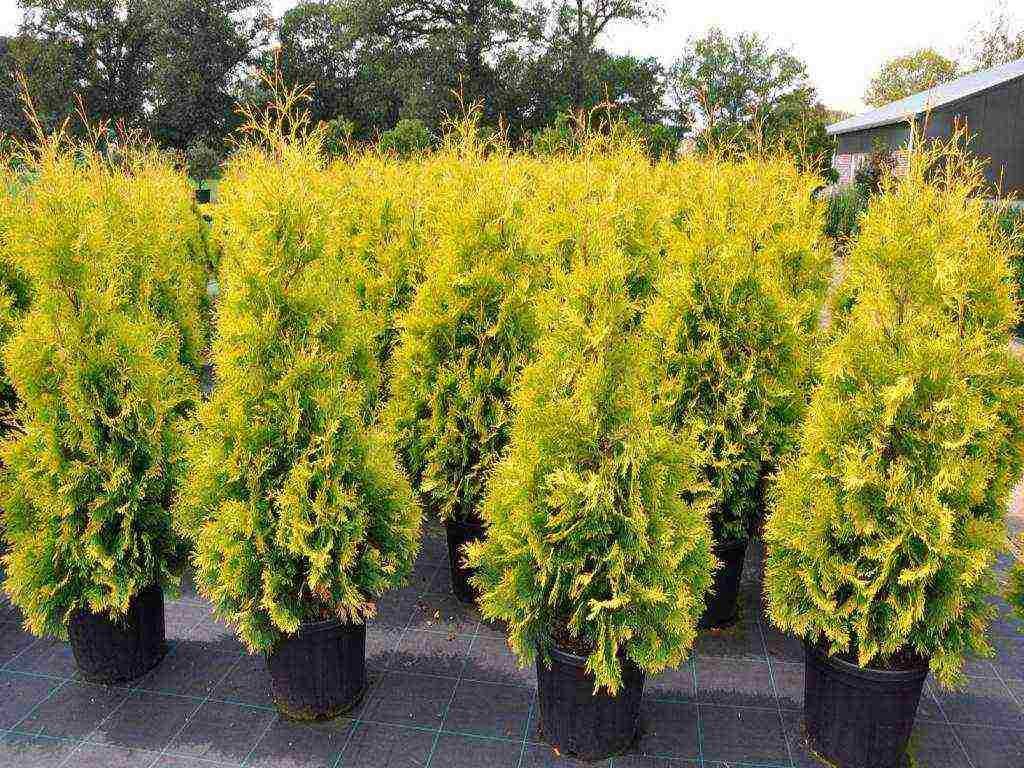
How much are the seedlings
The assortment of conifers is wide and varied.
The price of western thuja seedlings depends on the specific type and variety, as well as on the size of the seedling.
Thuja western Smaragd - from 200 rubles for small plants 15 - 20 cm high to 6000 rubles for plants more than 2 meters high.
Thuja western Braband - from 180 rubles for a seedling 15 - 20 cm to 3300 rubles for a 2 m seedling.
Thuja western Columna - a meter-long seedling costs within 750 rubles, a two-meter one - 3300 rubles. A sapling 15 - 20 cm costs about 180 rubles.
Thuja western Holmstrup - a seedling 0.2 - 0.4 m high will cost within 420 rubles, and 2500 rubles for a copy of 160 - 180 cm.
Thuja western Aurea Piramidalis - from 320 rubles for a seedling 0.15 - 0.20 m and more than 4000 rubles for a seedling 2 m high or more.
How to apply in landscape design and how many seedlings will be required
For landscaping the selected area, thuja act as:
- hedges;
- single trees;
- group landings.
To form a hedge, take species such as Smaragd, Braband, Yellow Ribbon, Columna and others. Saplings are planted at a distance of 0.5 - 0.8 m. The needles of these species do not turn brown in the winter season and do not change their decorative appearance all year round. Tui Excelsa, Aurescens suitable for group and single plantings, large-scale gardens and large parks, as these are tall plants. By the age of 10, they grow up to 8 - 12 m, 3 - 4 m wide. They sit in groups at a distance of 5 - 8 m.
Tui Excelsa, Aurescens suitable for group and single plantings, large-scale gardens and large parks, as these are tall plants. By the age of 10, they grow up to 8 - 12 m, 3 - 4 m wide. They sit in groups at a distance of 5 - 8 m.
Low-growing dwarf varieties are suitable for alpine slides and small flower beds: Aurea Pyramidalis (Thuja occidentalis "Aurea Piramidalis"), Smaragd (Smaragd), Holmstrup ("Holmstrup"). By the age of 10, these species reach no more than 2 - 3 m and have a crown width of 0.5 - 0.8 m.
When landscaping a summer cottage, courtyard, city flower beds, it is good to use several types of thuja at the same time, creating various compositions (photo). When planting, take into account the size of each plant in adult form, reserving space for them to grow.
It is good to combine conifers of different crown shape and color of needles (photo), choosing green and variegated, as well as two-color varieties.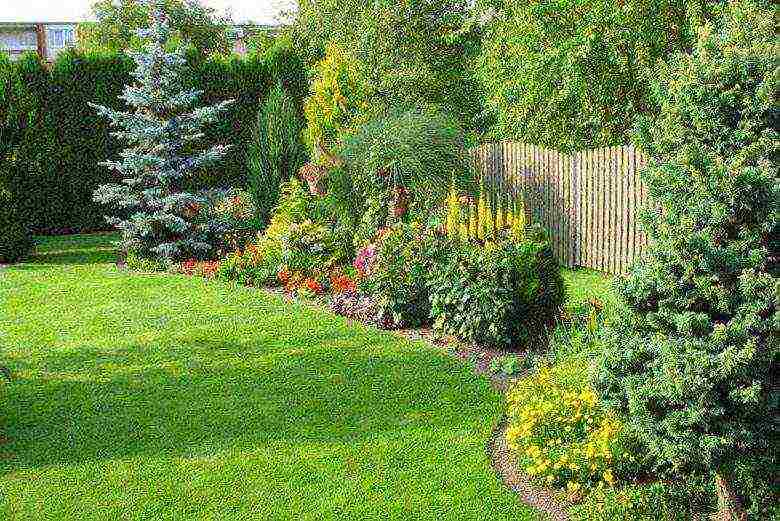
Before starting work, it is good to draw up a diagram of the future flower bed, so that it is easier to visually imagine and plan the placement of plants and calculate their number and distances between them. An example would be a photo of the diagram below: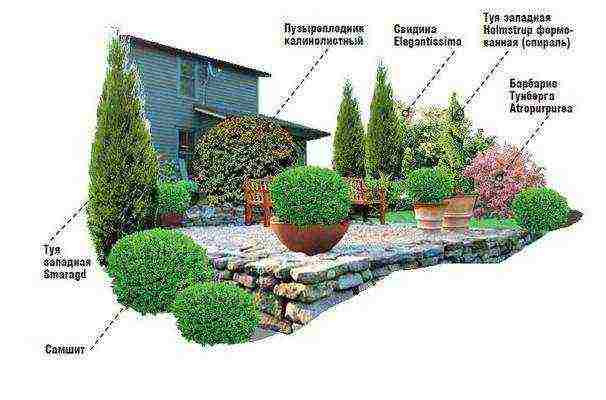
Due to its decorativeness, unpretentiousness and variety, the pyramidal thuja has become an undoubted favorite in landscape design. They look great both solo, and in hedges, and in plantings with other conifers, as well as with annual and perennial deciduous plants. Thuja pyramidal is beautiful at all stages of its life, does not lose its decorative effect in old age.
How not to get lost in the variety of tui?
In this article, we examined in detail only one form of thuja - columnar. In the video below, the specialists of the Greensad garden center introduce novice gardeners to the variety of thujas.
 A beautiful and well-kept plot is the dream of any gardener and owner of a private house. Today, designers can create absolutely any landscape composition, using both well-known plants and quite exotic ones. Thuja columnar is a variety of western thuja, which is an excellent decoration of the site, as it retains its bright green appearance throughout the year. |
This is a coniferous evergreen plant that has a charming aroma, dense crown and unpretentious care. Thuja western columnar can be used absolutely for any garden composition, to create a dense hedge, beautiful trees with an unusual crown shape, which is easily achieved due to the adherence of the branches to the trunk, providing a columnar shape.
In this article, we will consider the features of growing thuja columnar, we will give a description of the most popular varieties of this type of evergreen tree. We also note the important points of planting and caring for the western columnar thuja.
Morphological description and features of thuja columnar
Thuja western columnar is an evergreen coniferous plant that belongs to the genus gymnosperms. All varieties of thuja belong to the large Cypress family, which also includes juniper, cypress, cypress and many others.On the territory of Russia, representatives of thuja columnar are not found in nature. Around the 16th century, this plant came to the countries of Europe from East Asia and America, which are the natural habitat of thuja columnar. Now, many varieties of thuja western columnar are grown in gardens and household plots in temperate and northern latitudes.
The very name of the evergreen tree "thuja" has an ancient Greek origin. The scientific Latin name is based on the ancient Greek root, which in translation means "sacrifice, incense". This is due to the fact that some aromatic varieties of thuja in ancient times were used in rituals to obtain a pleasant scent.
Today there are 6 types of thuja, among which there are trees and shrubs with various crown shapes. There are several forms of thuja crown:
- columnar;
- pyramidal;
- shirokokonicheskaya;
- spherical.
All these varieties fit perfectly into any landscape design, creating the most incredible compositions and bizarre shapes. Among them, it is the columnar thuja that is especially popular, with the crown of which you can create incredible figures.
Description of thuja columnar:
- Thuja columnar is an evergreen coniferous tree or shrub that is naturally distributed in North America.
- In nature, this tree can reach a height of 20-25 m and is considered a tall representative of conifers, however, in gardens and summer cottages, thuja columnar can grow only 10-11 m, and most often this plant reaches 2-3 m.
- The root system of thuja is columnar powerful, but compact and does not grow much.
- The bark of the tree is light brown or reddish, flaking.
- Thuja columnar is the most durable member of this family and can grow in one place for about 100 years.
- In this type of tree, the crown has a pyramidal or columnar shape, hence the name thuja. In width, it can grow by about 1-1.5 m.
- The needles are very close to the trunk, located on horizontal branches. Thuja needles are represented not by needles, like in other conifers, but by tightly fitting scales.
- In summer, the needles have a dark green hue, and in winter they are brownish green. Updated approximately every 2-3 years.
- The scales are very small, only 2-4 mm in length.
- The flowers of this plant are not at all decorative, monoecious, located singly.
- After the end of flowering, a large number of fruits appear in the form of small cones on the thuja columnar.
- The length of one cone is about 1 cm, they are ovoid in shape and have two seeds with wings inside.
- Thuja columnar is an ideal evergreen plant for urban plantings, as this tree perfectly tolerates gas pollution, dustiness and lack of oxygen.
- This variety is distinguished by an excellent level of winter hardiness, it can withstand frost up to -36 degrees without shelter.
- Due to its dense crown, the thuja columnar is often used to create hedges and for windproof plantings.
- The tree lends itself well to pruning, however, the formation of a crown for a thuja columnar is not necessary, since it already keeps the shape of a column or a cone.
- Thuja columnar easily tolerates transplantation and is absolutely unpretentious to planting and care.
Variety of varieties of thuja columnar
Today there are a large number of thuja varieties that have a columnar or pyramidal crown shape. All of these varieties have found popularity and love among gardeners who use the columnar to create incredible landscaping. All varieties of thuja columnar are compact in size, reaching an average of 3 meters in height. Consider a description of the most popular and common varieties of thuja columnar.
- Variety "Brabant". It is a beautiful evergreen coniferous tree, which by the age of 10 can reach approximately 3-3.5 meters.The crown has a wide columnar shape, which can be about 1-1.5 m in diameter.This variety of thuja columnar is one of the fastest growing, a tree can grow by about 30-35 cm per year. time becomes greenish brown. Thuja columnar Brabant has a good level of frost resistance. Flowering begins around spring, after which cones are formed on the branches, which are ovoid. Cones in length reach 0.8-1.2 cm. Thuja of this variety perfectly tolerates shearing, the tree is not demanding to the planting site and to care. Ideal for creating dense hedgerows.

- Variety "Smaragd". The tree reaches a height of 2.5 m by 10 years, an adult thuja can grow up to 3.5-4 m. The crown has a narrow columnar shape up to 1 m in diameter. The needles of this tree have a bright green hue, which does not change even in winter. The branches are very close to each other, which makes the crown dense. This variety of thuja columnar is distinguished by a very slow growth rate, as well as a rather capricious attitude towards soil and watering. Thuja Smaragd is rarely used to create a hedge, since the upper part of the crown does not close. Ideal for solitary plantings or for conditional delimitation of a garden or site. It is a hardy tree that can be grown both outdoors and in a container.
- Columnar thuja variety "Columna". An adult plant of a thuja columnar Columna reaches 5-6 meters, by the age of 10 the tree can be about 2.5-3 m.It is distinguished by a narrow columnar crown, reaching 1.3 m in diameter.The crown is formed by short branches that are located very tightly to each other ... The needles have a rich green hue, which practically does not change in winter. Differs in a fairly rapid growth - up to about 20 cm per year. The thuja of this variety has a good level of winter hardiness, the tree is not demanding on the soil and tolerates cutting well. Tuyu Columna can be used to create hedges, as well as single and group plantings.

- Sort "Holmstrup". Thuja of this variety can reach a height of 2 m by 10 years, an adult plant can grow up to 3-3.5 m. It has a narrow columnar crown, which is formed by branches tightly adjacent to each other. The color of the needles is dark green, practically does not change in winter. The crown is very compact and dense. Thuja of this variety is very frost-resistant and unpretentious to the soil, perfectly tolerates a haircut. It grows slowly, in a year it can grow by only 10 cm. The final height reaches only 40 years. Used to create a hedge, for single and group plantings.
- Variety "Yellow Ribbon". Thuja of this variety is a tree that by the age of 10 can reach a height of 2.5-3 m. It is distinguished by a narrow conical crown shape, which has a low density. The needles are bright yellow. Whimsical to the composition of the soil, used in contrasting plantings.
- Variety "Aurea Pyramidalis". Thuja columnar of this variety in height can reach 5-6 meters, by the age of 10 you can get an evergreen beauty up to 2-2.5 m tall. It features a narrow pyramidal crown, which grows significantly over the years due to the fact that the tree has several trunks. The crown consists of flexible, slightly curled shoots. The variety is distinguished by its exactingness to soil and watering. It belongs to the group of frost-resistant varieties of thuja columnar. Used to create specimen and group plantings.

- Thuja variety "Aurescens". An evergreen tree grows on average up to 8-12 m in height, therefore it is most often used for very large-scale plantings in parks and alleys. The crown is columnar, rather wide, formed by dense and dense branches. The needles have a deep green shade with small white stripes. The variety is whimsical to the planting site and soil.
- Variety "Excels".This is a tall representative of thujas, which can reach a height of about 9-12 m. In width, the tree grows by 3-4 meters, therefore, most often thuja of this variety are used for planting in parks and for decorating powerful large-scale landscape compositions. The crown has a columnar shape, which is formed by arcuate shoots directed upwards. The needles are dark green saturated color, very shiny.
Reproduction of thuja columnar: the most common ways
Thuja columnar is one of the most popular evergreen trees for landscaping the site. This beautiful and bright tree can be bred without any problems on your own at home, for this you just need to know the most common methods and features of their use. Thuja columnar propagates in the following ways: by seeds and cuttings. Each option has its own rules, which are important to adhere to in order to obtain a healthy and strong tree.
Seed reproduction of thuja columnar
- This method of propagation is rarely used, since the result is a plant without maternal traits and varietal differences. Most often it is used by breeders to develop new varieties of thuja.
- A young plant can be obtained only after 5-6 years.
- To breed a thuja columnar in this way, you will need freshly harvested seeds that ripen by autumn.
- They must first be removed from the cones. To do this, the collected ripe cones are placed in a warm place for a while - this is necessary so that the scales open. After that, the seeds are removed.
- Before planting, the seeds must be soaked in water for about 10 hours.
- Further, the planting material needs to be stratified. This process can be carried out in natural conditions under the snow, or you can put the seeds in the soil and put the container in the refrigerator.
- Seeds of thuja columnar are sown directly into open ground to a depth of only 0.5 cm. On top of the beds, it is enough to sprinkle with sawdust of a coniferous tree.
- It is important to cover thuja crops from the sun and constantly loosen and water.
- For the first season, young seedlings of thuja columnar grow only 7-8 cm.
- For the winter, crops must be covered with spruce branches and foil.
- Thuja seedlings are planted in a permanent place in the third year, when young plants grow up to 50 cm.
Propagation of thuja by columnar cuttings
- Propagation by cuttings is one of the most popular ways to obtain young seedlings of thuja columnar.
- Planting material for planting is harvested in June. For this, two-year-old shoots approximately 20-40 cm long or annual branches 10-15 cm long are used.
- Thuja cuttings cannot be cut, they must be torn off with a piece of bark, the so-called heel. After that, the cut site is treated with heteroauxin or charcoal.
- Before planting, all cuttings can be placed for a while in a root former solution, which will facilitate the fastest rooting.
- Planting material is planted in greenhouses or a greenhouse, you can also use containers.
- A soil mixture of turf, peat and sand is suitable for rooting cuttings. Before planting, it is recommended to spill the earth with a weak solution of potassium permanganate.
- The cuttings are rooted to a depth of about 1.5-2 cm.
- After planting, all planting material is covered with a film to maintain the required level of humidity and temperature.
- Cuttings of thuja columnar prefer very humidified air, the plants are not watered, but sprayed from a spray bottle.
- After rooting, the cuttings begin to air and harden a little, after which the film is completely removed.
- In late autumn, the cuttings are covered with spruce branches and foliage, and in severe frosts they are covered with a film.
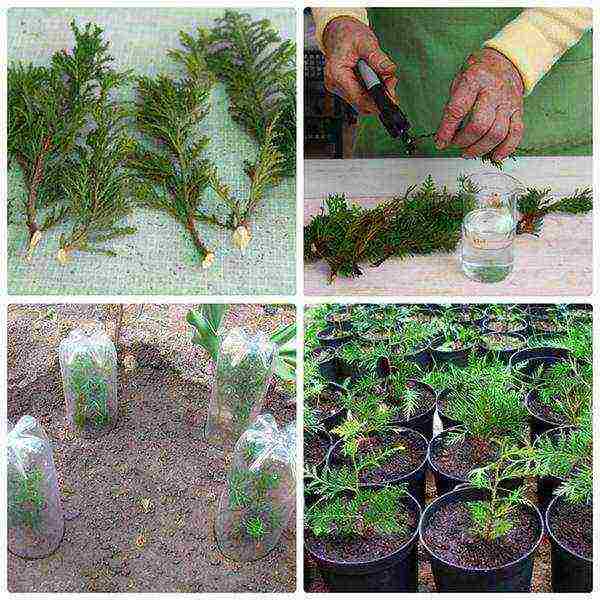
Preparation before planting a thuja columnar
Thuja columnar is considered one of the most popular trees among gardeners, since this evergreen plant is distinguished by its unpretentiousness and good frost resistance, which is important when growing plantations in the climatic conditions of our country. Growing thuja is not difficult even for novice gardeners, it is enough to carry out competent preparatory work. First of all, you need to purchase high-quality and healthy seedlings and find an ideal place on your site for planting a young tree.
Stage 1. Selection of variety and seedlings of thuja columnar
- The success of the correct planting of thuja columnar is the selection of a suitable tree variety. It is important to choose an evergreen tree with a good level of frost resistance, especially if you plan to plant seedlings in temperate climates.
- The choice of seedlings will also depend on the intended planting site, where it is important to consider the height of the adult plant. The approximate height of an adult columnar thuja is 2.5-3 meters.
- You can buy thu columnar in specialized garden stores or nurseries that are professionally engaged in plant breeding.
- In the store you can buy seedlings of different ages and different heights. It is best to buy young plants from 2-3 years old, they will take root better.
- Be sure to check the condition of the seedlings before purchasing. There should be no visible damage, dry or yellow needles on them. The soil in the container must be moist and clean. The plant should also be free of signs of disease or pests.
- Seedlings with a closed root system can be purchased at any time of the year.

Stage 2. Choosing a place and soil for planting a thuja columnar
- Thuja columnar prefers to grow in well-lit sunny places, however, it is important that direct sunlight is only part of the day.
- It is necessary that the site has natural or artificial shading of young trees. In the open sun, the needles may turn yellow.
- The choice of a place for planting will also depend on the planned garden composition, for this you need to select seedlings of various heights.
- Also, when choosing a site, it is important to remember that the columnar thuja does not tolerate drafts, especially for young seedlings.
- The plant prefers a nutritious and fertile soil, consisting of sod land, peat and sand, better than river. You can pick up a place with loamy ground.
- Thuja loves moist soils, however, it has a negative attitude to stagnation of water at the roots, so select slightly elevated areas and places where there is no close occurrence of groundwater. You can take care of a good drainage layer before planting.
Planting a thuja columnar in open ground
- In temperate latitudes, it is recommended to plant thuja seedlings in a columnar spring, since autumn planting does not guarantee the rooting of a young plant before the onset of winter.
- It is important to prepare the soil for planting before planting. To do this, the selected area must be carefully dug up and all rhizomes of nettles and other weeds must be removed, as they can drown out the growth of thuja. After that, peat and humus are added to the soil, while the natural fertilizer should not be fresh. The use of monthly manure is allowed.
- All thuja are columnar in height reach an average of 2-3 meters by 10 years, respectively, their root system is quite powerful. The planting holes should be 20-30 cm larger than the roots with an earthen clod. The approximate dimensions should be as follows: 60-100 cm in depth and width.
- When preparing the planting holes, also consider how many seedlings will grow nearby. If you are planting several thujas, keep a distance of about 1.5-2 m.When creating a hedge, the distance should be less, about 50-60 cm.
- A drainage layer must be placed at the bottom of each planting pit. This will remove any remaining moisture from the roots. Broken bricks, small stones or gravel can be used as drainage.
- Next, you need to prepare the seedlings. The soil in containers is watered abundantly, after which the plant is carefully removed along with an earthen clod around the roots.
- A soil mixture is poured onto the drainage layer, and then the seedlings are placed.
- It is important to ensure that the root collar is slightly above the soil surface.
- Cover the seedlings with soil and compact it very carefully with your hands, being careful not to damage the plant.
- After planting, each plant must be watered abundantly. One seedling should have about 2-3 buckets of water.
- The trunk circle must be mulched to protect the root system from temperature extremes. Sawdust, tree bark, peat can be used as mulch. It is important to ensure that the mulch does not cover the trunk and lower branches. From this they can start cheering.
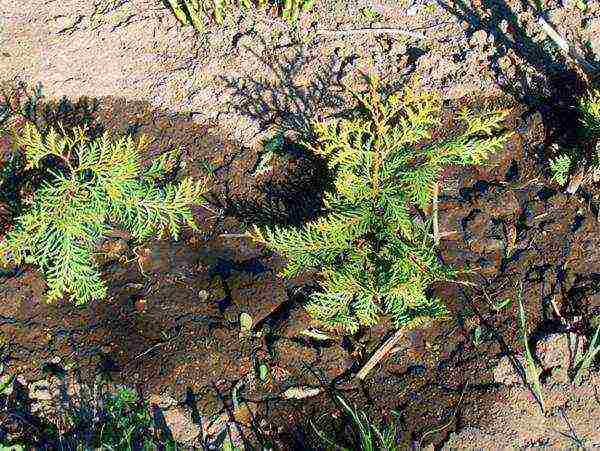
Agrotechnology for growing thuja columnar: secrets and nuances of care
Caring for thuja columnar does not require additional knowledge - it is exactly the same as caring for other representatives of this genus. The main thing is to pay attention to the plant, especially in the first years after planting.
- Watering. Thuja columnar needs regular and abundant watering, since when the needles of a tree dry out, they can begin to dry and turn yellow. Young seedlings are watered about 2 times in 7 days, using 2-3 buckets for each plant. During the growth period, the thuja columnar is watered 1-2 times a week. Each seedling should have 1.5-2 buckets of water. This plant is also very supportive of sprinkling, therefore, when planting in spring, it is recommended to spray the crown with a hose. If the summer is very hot, then you need to spray the thuja twice a day, in the morning and in the evening, this will remove dust from the tree and saturate it with moisture.
- Loosening and mulching. The soil around the seedlings must be loosened regularly. This should be done to a depth of 10 cm. After each loosening of the soil, it is important to add mulch to retain moisture at the roots and protect from direct sunlight. The bark of coniferous trees or peat is used as mulch. It is recommended to remove all weeds that may interfere with the full growth of the seedlings.
- Top dressing of thuja columnar. If a colonial thuja seedling is planted in a nutritious and fertile soil, then it is enough to fertilize the soil 2 times per season. In this case, the first feeding is applied only after 2 years. The first time they feed the thuja in the spring, while using nitrogen-containing fertilizers such as ammonium nitrate. The second time feeding is applied at the end of summer, during this period you can use calcium and phosphorus fertilizers such as nitroammofoski.
- Thuja pruning. Columnar thuja have a pyramidal or conical cone shape, but this does not mean that from the moment of planting, the crown of each plant grows perfectly even. There are varieties in which needles fluff and require pruning. When buying, it is important to inspect the seedling, usually these plants have several leading shoots, it is important to remove all but one. Pruning should be done in the spring, removing all dry and broken branches. When forming the crown, it is allowed to cut branches by a maximum of 1/3 of the length.
- Preparing for winter. Thuja columnar is a frost-resistant plant, however, its branches growing upward can break off from snow and ice. To prevent this from happening, it is important to build a reliable shelter. You can put wooden slats in the form of a hut around the seedling and wrap them in burlap or white lutrasil.
Photo of thuja columnar
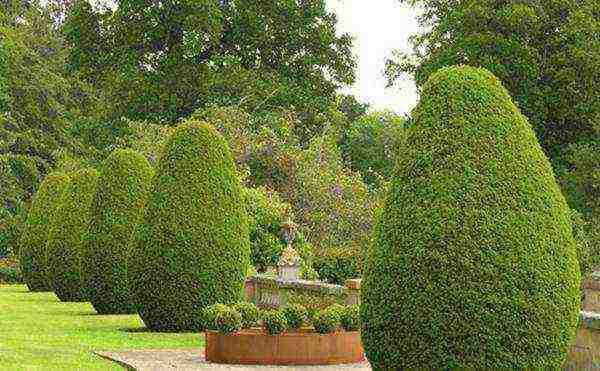



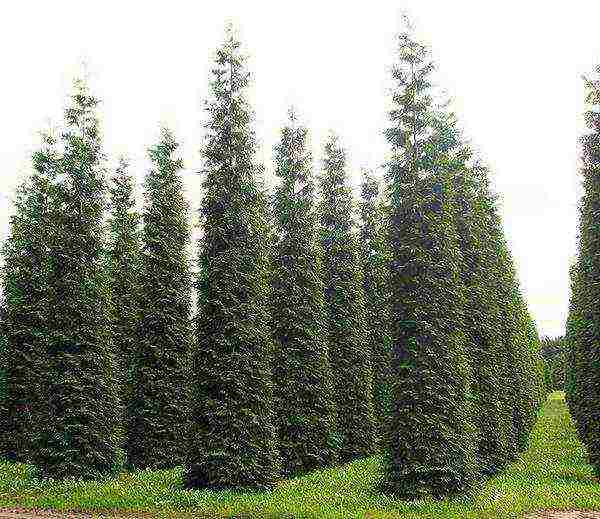
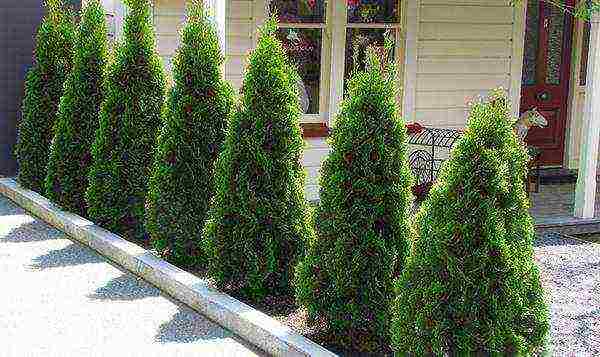
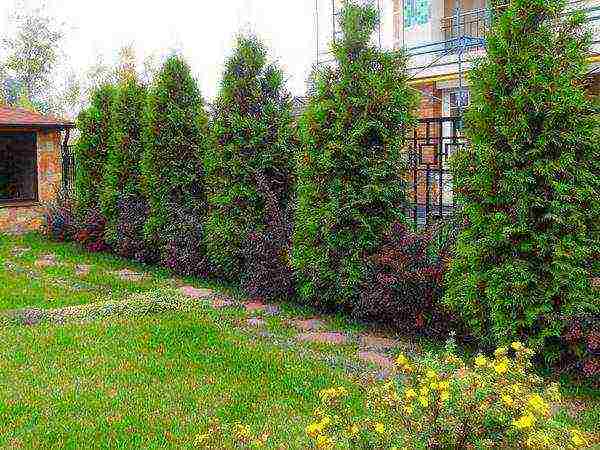
Thuja columnar is an evergreen beauty that can be grown without problems in a cooler climate than the natural habitat. Do not be afraid, there will be no difficulties with planting and leaving, since this plant is quite unpretentious if all the rules for preparation and planting are followed. As a result, you will get a beautiful and modern plot with gorgeous conifers.

